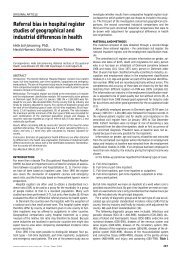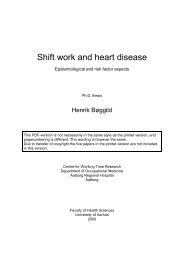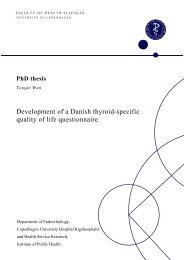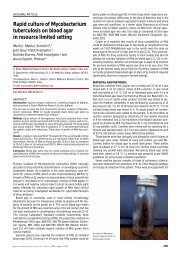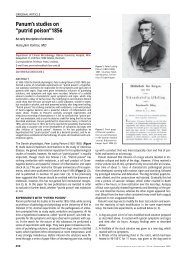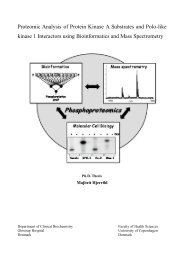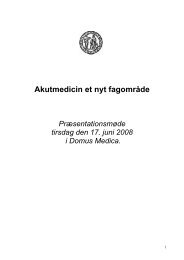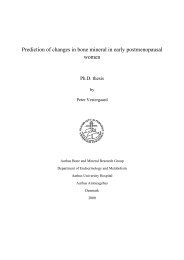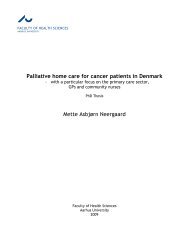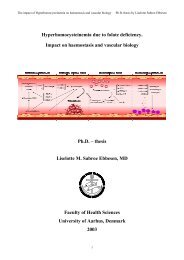Acute stroke â a dynamic process - Danish Medical Bulletin
Acute stroke â a dynamic process - Danish Medical Bulletin
Acute stroke â a dynamic process - Danish Medical Bulletin
You also want an ePaper? Increase the reach of your titles
YUMPU automatically turns print PDFs into web optimized ePapers that Google loves.
Tabel V 1. Comparison of ECG abnormalities in patients with <strong>stroke</strong> and<br />
controls in literature.<br />
N <strong>stroke</strong> % abn. N % abn.<br />
Author patients ECG or* controls ECG or*<br />
Lavy et al (140) . . . . . . . . . . . . . 200 68 % 200 29.5%<br />
Dimant et al (134) . . . . . . . . . . . 100 90 % 50 50 %<br />
Norris et al (139) . . . . . . . . . . . . 312 50 % 92 22 %<br />
Goldstein et al (137) . . . . . . . . . 150 92 % 150 65 %<br />
Myers et al (104) . . . . . . . . . . . . 100 225* 50 52*<br />
*) Number of serious arrhythmia hours in observation period.<br />
Another question is whether the rates of ECG abnormalities in<br />
patients with acute <strong>stroke</strong> differ from the rates of otherwise comparable<br />
patients. At least five studies have compared the rates of ECGabnormalities<br />
in patients with <strong>stroke</strong> with a control group including<br />
surgical patients, patients with other neurological diseases than<br />
<strong>stroke</strong>, or other age and sex-matched patients (104; 134; 137; 139;<br />
140). They all found higher frequencies of ECG-abnormalities in<br />
patients with <strong>stroke</strong> than in controls, however frequencies varied<br />
largely, Table V 1.<br />
It has previously been reported (129) that mortality was increased<br />
in patients with ECG-abnormalities and that arrhythmias were most<br />
frequent in patients with haemorrhagic <strong>stroke</strong> and hemisphere lesions<br />
(116). The question of a relation between ECG-abnormalities<br />
and the severity of the neurological deficit has previously been addressed<br />
by Lindgren et al (131), who in a study of 24 patients found<br />
no relation between ECG findings and lesion size or outcome. We<br />
found in patients with ischaemic <strong>stroke</strong>, but not in haemorrhagic<br />
<strong>stroke</strong>, that significantly more severe deficits (lower SSS) were found<br />
in patients with atrial fibrillation, prolonged QTc, atrio-ventricular<br />
block, ST-depression, and ST-elevation than in patients without<br />
those abnormalities. Atrial fibrillation causes <strong>stroke</strong> through a cardio-embolic<br />
<strong>stroke</strong> mechanism that generates more severe <strong>stroke</strong>s; it<br />
is therefore not surprising that more severe <strong>stroke</strong>s are found in patients<br />
with atrial fibrillation however, ST-segment changes may result<br />
from e.g. a stress response or be cerebrogenic cardiac effects.<br />
In patients with ischaemic <strong>stroke</strong>, ECG abnormalities predicted<br />
three months mortality: atrial fibrillation, OR 2.0 (95% CI 1.3-3.1),<br />
A-V block OR 1.9 (95% CI 1.2-3.9), ST-elevation OR 2.8 (95% CI<br />
1.3-6.3), ST-depression OR 2.5 (95% CI 1.5-4.3), and inverted T-wave<br />
OR 2.7 (95% CI 1.6-4.6) independent of <strong>stroke</strong> severity, pre-<strong>stroke</strong><br />
disability and age. In patients with ICH, sinus tachycardia OR 4.8<br />
(95% CI 1.7-14.0), ST-depression OR 5.2 (CI 95% 1.1-24.9), and inverted<br />
T-wave OR 5.2 (95% CI 1.2-22.5) predicted mortality at three<br />
months, independent of pre-<strong>stroke</strong> disability, <strong>stroke</strong> severity, and age.<br />
Our findings that ECG abnormalities relate to outcome, are in accordance<br />
with Lavy (129) and Miah (141) while Myers et al suggested<br />
that cardiac arrhythmias had little influence on subsequent<br />
recovery in patients with ACI or ICH (104). A larger number of patients<br />
should, however, render our results more robust.<br />
The findings from a large recent study in patients with TIA (142)<br />
suggested that ECG-changes – especially atrial fibrillation – predicted<br />
and directly affected outcome. This is not surprising, as ECGchanges<br />
such as atrial fibrillation, at least high degree atrio-ventricular<br />
block, or ST-elevation are well known to affect prognosis in<br />
any patient as they represent significant cardiological conditions<br />
that call for treatment. A possible prognostic impact of an inverted<br />
T-wave is more intriguing as this does not seem to be a serious condition<br />
in itself.<br />
ECG-changes in acute <strong>stroke</strong> may reflect the aetiology of the<br />
<strong>stroke</strong> (124) like in atrial fibrillation, reflect the general cardiac condition<br />
of the patient – like in atrio-ventricular block – which may<br />
well be a determinant for prognosis, or changes may directly result<br />
form the cerebral lesion. This may either result from global effects<br />
such as increased intracranial pressure or local effects such as lesions<br />
to the insular regions. The relation of transient changes to <strong>stroke</strong> severity<br />
supports the idea that generalised cerebral mechanisms, e.g.<br />
increased intracranial pressure, generate ECG-abnormalities after<br />
cerebral lesions in contrast to the theory that it is caused by lesions<br />
to specific structures like the insula.<br />
Another aspect of heart function in acute <strong>stroke</strong> is the heart rate.<br />
Sinus tachycardia predicted poor outcome in patients with ischaemic<br />
and haemorrhagic <strong>stroke</strong> independent of neurological deficit.<br />
Heart rate was significantly higher in severe <strong>stroke</strong> than in mild to<br />
moderate <strong>stroke</strong> and followed a different time course: in mild to<br />
moderate <strong>stroke</strong>, heart rate declined rapidly after admission,<br />
whereas a slow decline at a higher heart rate was observed in severe<br />
<strong>stroke</strong>. In the analysed interval from 6-14 hours after <strong>stroke</strong> onset, a<br />
risk increase of 1.2-1.3 for three months mortality with each increase<br />
in heart rate of 10 bpm. Pulse rate higher than median, 12<br />
hours after admission predicted three months mortality OR 1.7<br />
(95% CI 1.02-2.7) independent of age, pre-<strong>stroke</strong> mRS, <strong>stroke</strong> severity,<br />
and body temperature (measured at the same time as heart rate).<br />
The heart rate reflects the stress response, which is a likely explanation<br />
for the observed effect as the stress-response is important in<br />
determining the heart rate in a resting person with normal body<br />
temperature (107). This interpretation is in accordance with the<br />
finding that s-cortisol correlates to heart rate and predicts three<br />
months mortality.<br />
In conclusion, ECG-abnormalities are frequent in acute <strong>stroke</strong> and<br />
may reflect both cardiac morbidity and the <strong>stroke</strong> incident. Some<br />
ECG-abnormalities and increasing heart rate predict poor recovery.<br />
CARDIAC TROPONIN I (PAPER VI)<br />
Cardiac troponin I (cTnI) is a protein of the thin filament regulatory<br />
system of the contractile complex of the heart that is specific for the<br />
myocardium in contrast to cardiac troponin T (cTnT), where isoforms<br />
are detected in injured skeletal muscles (143). Cardiac TnI<br />
and cTnT are extensively used in detecting myocardial injury, as the<br />
sensitivity is superior to the sensitivity of the CK-MB test, cTnI being<br />
the most sensitive (144; 145).<br />
The analysis of cTnI or cTnT is at the present standard in establishing<br />
the diagnosis of acute myocardial infarction, however it has<br />
also proven useful in detecting other kinds of myocardial damage,<br />
including post-mortem documentation of cardiogenic sudden death<br />
(146). Cardiac troponin I is a predictor of in-hospital clinical outcome<br />
as well as of cardiac risk in patients with unstable angina (147;<br />
148). In congestive heart failure, troponin-levels parallel the severity<br />
of the disease (149). Cardiac troponin I predicts short-term mortality<br />
after vascular surgery (150), adult cardiac surgery (151), and<br />
minor increases in cTnI predict decreased left ventricular ejection<br />
fraction after high-dose chemotherapy (152). Cardiac troponin I<br />
elevation has been demonstrated in otherwise healthy subject following<br />
ironman triathlon competition, but in this case decreased<br />
ejection fraction documented that significant myocardial damage<br />
was present (153).<br />
Elevation of cTnI or more frequently cTnT without a link to myocardial<br />
injury may occur in patients with severe renal dysfunction<br />
(154), however, unexplained elevations of cTnI are considered rare.<br />
A small number of studies have dealt with cTnI or cTnT in acute<br />
<strong>stroke</strong>. This is a relevant issue because <strong>stroke</strong> has well documented<br />
cardiac consequences and relations to the less cardiospecific CK-MB<br />
enzyme have been described. ECG-abnormalities occur after <strong>stroke</strong><br />
and may be related to increased sympathetic tone especially after<br />
right-sided insular lesions (155). If this increased sympathetic tone<br />
– or any other cerebrogenic influence on the heart – resulted in actual<br />
damage to the myocytes, increased levels of troponin would be<br />
expected. In case of a relation to sympathetic tone, a relation to<br />
stress hormones and insular, especially right insular lesions would<br />
be expected. However, the issue is rather complex in this patient<br />
population, as patients with acute <strong>stroke</strong> have a high prevalence of<br />
heart disease, like congestive heart failure that may also cause increased<br />
levels of troponin.<br />
We investigated cTnI in a population of 172 patients with acute<br />
216 DANISH MEDICAL BULLETIN VOL. 54 NO. 3/AUGUST 2007



